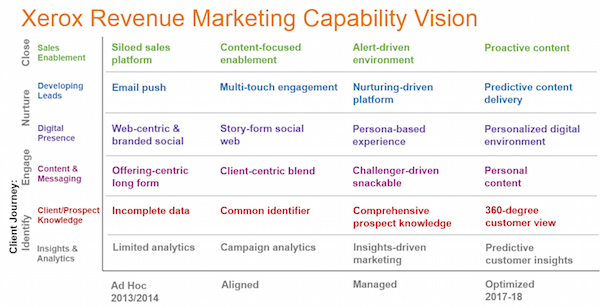Okay, perhaps that headline sounds a tad too much like a salacious exposé, which this is not.
This is, however, an enlightening Q&A with Jason Seeba, lead marketing technologist at BloomReach, a rapidly growing Silicon Valley company that creates big data marketing applications used by major Internet retailers such as Neiman Marcus, Williams-Sonoma, and Wine.com.
Jason candidly answers several of the most common questions that arise around the role of a marketing technologist:
- What kind of background do great marketing technologists have?
- How does one become a marketing technologist?
- What does a modern “marketing technology stack” look like?
Of course, the answers to those questions can vary significantly, from one marketing technologist to another. So think of what follows as examples more than requirements.
However, I think you’ll find Jason’s walk-through of BloomReach’s marketing technology stack — the collection of different software products that they use together to achieve their own, special blend of technology-powered marketing goodness — to be a particularly helpful example of the usefulness of a heterogeneous stack.
One of the common reactions people have to my marketing technology landscape graphic is: what do you need all these different applications for, anyway? Jason tells us which different solutions BloomReach uses and why. (And at least a few of the products that he mentions were new discoveries for me too!)
When I connected with Jason, they were in the middle of their latest product launch — BloomReach SNAP (Search, Navigation, and Personalization), which personalizes site discovery mechanisms for consumers in real-time. So I greatly appreciate him taking a little time to share with us his perspective on the role of a marketing technologist.
1. To start, can you tell us a little about your background and your career path as a marketing technologist?
I grew up in Silicon Valley and was that nerdy kid that called up BBSes and took apart and rebuilt my computer far too often. In high school, we started the world’s first high school Internet radio station and ended up pulling down 10M listeners a year as one of the first alternative music stations on the web.
I went to college and started another station. Then after freshman year, I joined the early team at a startup doing peer-to-peer audio streaming before Napster. I helped write the business plan, which we used to raise $15M in funding. I was 19 years old, but with four years doing Internet radio, I had more direct experience than just about anyone there. We signed a number of radio networks to early deals and competed head-to-head with Broadcast.com.
After finishing undergrad and an MBA, I moved to Prague for a year to teach English. I came back to the Valley because I had developed a real love for getting in on big ideas from the very beginning. I started by helping get a scrappy, bootstrapped startup off the ground that was ripping people’s CD collections. We differentiated on high-quality metadata, hacked together some basic robots to rip CDs, and built a successful channel strategy with the home theater installer market. We also partnered with Sonos and Best Buy to beat out a well-funded competitor ($20M) that opened 10,000 ft. of office space in San Francisco.
After that, I joined an angel-backed startup that was working on technology for healthcare performance improvement. It was a small team, and I was trying to figure out how to use technology to scale our sales and marketing efforts. We started with Salesforce and Marketo. I had used a number of marketing technologies before, but once I got a good understanding of the power of marketing automation, we were better able to prioritize our efforts and get some good traction.
Most recently, I joined BloomReach, which is a company that has built some very interesting marketing technology. We’re focused on personalizing discovery using machine learning and big data, primarily for online retailers.
Prior to BloomReach, the startups I joined were pre-revenue and sales/marketing team. I learned a lot from building out the teams and bringing together the marketing technologies we would use (and looking back made plenty of mistakes along the way).
2. Your title at BloomReach is Lead Marketing Technologist. Where does that role sit in your organization and what does it entail?
I report directly to our Head of Marketing (CMO) and work closely with the rest of our marketing team, along with our sales, account management, and finance teams. I also manage our marketing technology and sales development (early stage prospecting) team.
Bringing in the right technologies and people to drive [marketing and sales], while working with other teams to use those technologies to improve their jobs and scale their efforts.
We’re working on building the engine that drives marketing and sales at BloomReach. To me that means bringing in the right technologies and people to drive it, while working with other teams to use those technologies to improve their jobs and scale their efforts. It encompasses all things demand gen, including sales/marketing operations.
In the spirit of the other early-stage startups I’ve been part of, ultimately my own personal mission is to improve anything in marketing/sales that can help the business move forward. I feel like I am able to pursue whatever task/project/initiative that could help — and thankfully the organization has been very supportive of those efforts.
3. How can someone in your position help his or her organization understand the value of marketing technology — and, for that matter, marketing technologists?
I think the way to best help an organization understand the value of marketing technology is to create personal value for every stakeholder.
Start with finding an intellectually honest way to track the value of marketing and its contribution to the bottom line. Figure out what the ROI of each marketing channel and program is and use that data to optimize your marketing spend. With that in place, you can begin to tie the conversation about marketing to revenue and can gain real legitimacy.
Listening to people’s challenges and knowing enough about your own technologies and the ones in the market that you can help overcome them.
Next, you can help every group in the company make its job better and easier with technology. This means spending time with team leaders and helping them use the data to help them make better decisions. It means making sure your sales and marketing teams are continually trained and that any process that you put in place actually makes their live easier. It means listening to people’s challenges and knowing enough about your own technologies and the ones in the market that you can help overcome them.
You have to make sure that the analytics and impact are both visible — but in my opinion, the best way to show the value of the technology is to serve others with it.
Savvy marketing technologists are in a unique position to use technology as a catalyst for change.
Having someone who intimately understands your business and can use technology to get the right process in place can be very valuable, especially in a growing company. Savvy marketing technologists are in a unique position to use technology as a catalyst for change.
4. What’s it like being a marketing technologist at a marketing technology company? How has that affected your worldview of what makes great marketing technology?
It’s a real treat. Getting to work everyday with some of the smartest engineers in machine learning on bleeding-edge marketing technology is pretty much a marketing nerd’s dream come true.
Honestly, before BloomReach I had lower expectations of marketing technologies. I expected a good marketing technology to basically streamline a process and integrate with others, so you could analyze data and make better decisions. Now, I expect systems to take action for me — within bounds — and continually learn and improve.
BloomReach gave me better evidence that I can trust machine learning and algorithms to intelligently make the right marketing decisions. We all use these types of technologies everyday when we’re searching with Google, but most marketing tools haven’t yet caught up.
Traditionally, we’ve had rules-based systems in marketing — marketing automation or workflow in a CRM for example — that have helped marketers automate tasks, but there’s just a limit to how many rules, A/B tests, and improvements you can manually manage.
There are many applications in marketing where machines should be testing, learning, and improving in a more autonomous fashion. A great marketing technology helps you automate where you can automate, but then should give you intelligent analytics to help you add value where needed.
5. Can you share with us which marketing technologies you’re using at BloomReach? What do they each excel at and, at a high-level, how are they pieced together?
Salesforce — Our sales system of record and the conduit that holds together our marketing, sales and account management efforts. Most of the systems below integrate into Salesforce in one way or another.
Marketo — The marketing automation system that we use to power our nurturing, lead scoring, alerting, landing pages, etc. We run all of our marketing programs through Marketo and track all of our marketing touches to revenue with both first-touch and multi-touch attribution.
Leadspace — Think of Leadspace as eHarmony for leads. A company can build a fairly comprehensive profile with hundreds of attributes for each product they sell. Leadspace will then automatically score existing leads against those profiles and find the best leads within target companies that fit your profile. It makes our marketing automation much more valuable because we can automatically score leads based on their potential fit for each one of our products — and tailor our outreach accordingly.
BuiltWith — A great way to find out which specific web technologies our target companies are using.
InsideSales.com — Our sales development team uses their PowerDialer application to help automate their calling from Salesforce.
LeanData — These guys provide a great service to de-dupe leads/contacts and automatically move leads to contacts and accounts in Salesforce.
Heap Analytics — Website analytics with event tracking that is retroactive — meaning you don’t have to set up anything to track a new event. You can just define it and can look back over your existing data.
BloomReach — We’re using our own technology to give us insights into what content is working and what content should be created in the future.
Some others: Fuze and GoToWebinar for events and webinars, Tout for basic email tracking for our prospecting reps, Wrike for task tracking/project management, HootSuite for all things social, Twilio to tie marketing automation to phone/SMS, etc.
6. Marketing technologists are still a relatively new breed in most marketing departments. How do you promote good collaboration between marketers who lean towards creative arts and those who are more technical?
Both sides can come together pretty naturally. Even though there are times when we’re speaking a bit of a different language, it helps that we recognize the common goal — and that we need to work well together to drive the most revenue.
Also, if you’re a marketing technologist and you are successfully tracking all of your marketing programs to revenue, it can be one of the first times that the creative side can see how their work directly influences pipeline generation and ultimately revenue won. It can help them to see what’s working and what’s not in a more quantitative way. Create dashboards where they and others can easily see the impact.
7. What advice would you offer to someone starting their career who thinks this marketing technologist career sounds pretty cool?
First off, being a geek and at least basically analytical really helps.
I found it really helpful to be a part of very small, scrappy teams where you’re building the marketing machine. You get a chance to really understand the technology, the process, and the potential impact.
Next, I found it really helpful to be a part of very small, scrappy teams where you’re building the marketing machine. You get a chance to really understand the technology, the process, and the potential impact you could have in a way that you can’t if you’re coming in to a more established company as a marketing manager charged with managing campaigns in a marketing automation system. You also get to learn your business in a much more intimate way when you’re building it from scratch.
Find smart people with similar values to learn from and to work with. When you’re interviewing for a position make sure that the people you’re planning to work with and report to are smart, thoughtful, and a mirror of who you’d like to become in some ways. I’ve had mentors/colleagues over the years that have been invaluable.
Also, make sure that your values line up with the organization’s values. If you haven’t thought about your personal values, spend some time doing it. It’s worth the investment of time.
Learn, learn, learn the newest technologies. Let vendors and analysts educate you. Then get in and use them yourself.
Get involved in user groups and online communities. Online marketing groups can be okay, but many times they’re filled with spam and self-promotion. Find people locally that you can connect with. People are very willing to share what they’re doing, especially if you’re open with what you’re working on. I’ve been a part of the Silicon Valley Marketo User Group over the last few years. It’s been a great place to learn, share ideas, and grow alongside other smart marketers.
You also have to be comfortable with change. Marketing technologies are coming and going at an incredible clip.
You also have to be comfortable with change. Marketing technologies are coming and going at an incredible clip. Trying to navigate the newest technologies and finding the ones that will move the needle could be a full-time job — but picking the right ones and getting them sewn into the fabric of your organization will give you an edge.
If you’re an early adopter, embrace new marketing technologies as they are developing and help drive those marketing technologies forward. Give thoughtful feedback to those early companies and push them to build something great.
Align with companies that have a high potential for growth. There will always be opportunities at growing companies.
Become an expert at CRM and marketing automation systems since these are the systems-of-record that most other technologies will have to plug into. If you can quickly and easily access data for people, you’ll be invaluable to executives and other business owners.
Finally, finally, just jump in and go for it. It’s an exciting time to be a marketing technologist.
Thank you, Jason!



